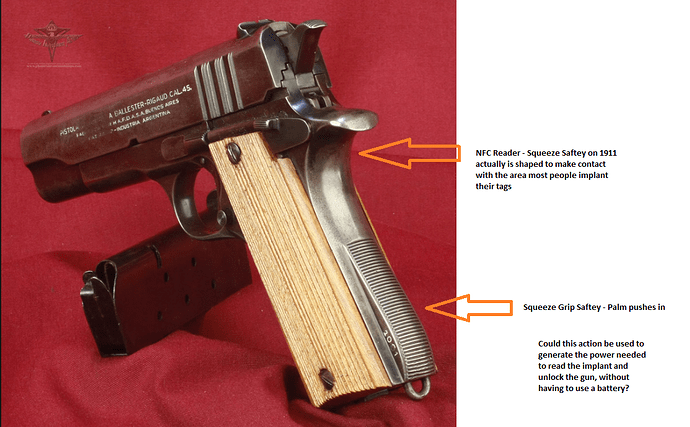Other then unlocking locks, doors, phones, and computers, I have had interest in using implants to unlock guns.
But, every single smart gun design or concept I’ve seen seems overly complicated and prone to failure. If I built/owned a smart locked weapon, I would want it to unlock and fire faster than a weapon with a regular safety. I would want to it be actually more reliable than having to feel and check if my regular dumb weapons safety is engaged or not.
Also, I wouldn’t want to have to worry about large, complicated, and battery powered electronics inside the weapon.
This all made me think of the Colt 45 1911, an almost 120 year old iconic American weapon from WW1 that is still relevant today. Unlock most weapons today, it has a large mechanical Grip Squeeze Safety, that is actually shaped to make near perfect contact with the location where most biohacking enthusiasts implant their tags. This design was implemented on the 1911 so soldiers fighting in the muddy and sometimes chaotic trenches of Europe wouldn’t have to worry about accidently blowing their man parts off but also knew that when they drew their weapon, they could trust that it would put down the Kraut they were struggling with.
Can this large mechanical lever action of the 1911 squeeze safety grip potentially generate the necessary power to briefly energize a small capacitor, power up a small NFC reading SoC, and then if it authenticates an authorized tag, finally trigger a small actuator that would allow the weapon to complete the unlock/arming action?
Would pursuing this concept or some kind of similar concept be a waste of time? Is generating the necessary power with such an action outside the realm of feasible?
The formula for potential electricity generated with kinetic motion at 100% efficiency is:
Watt.seconds ~= kg_force x metres travelled x 10.
What I have no idea about is how much power such an SoC would theoretically require. Does anyone have thoughts on this?
